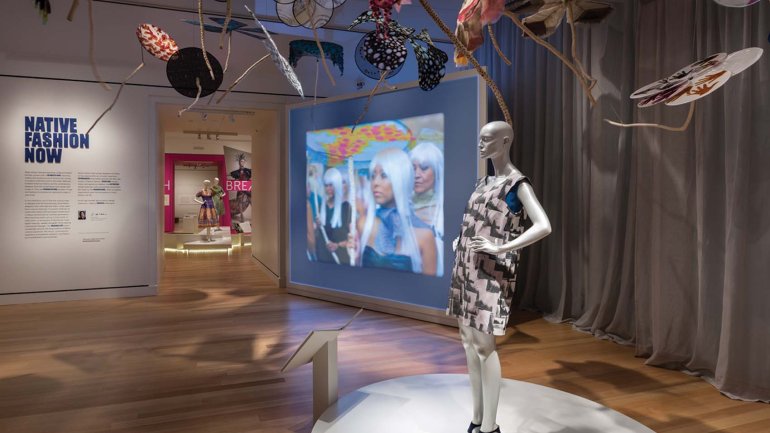Native Threads
Native Threads
A few years ago, Karen Kramer noticed a surge of interest in Native American fashion. A curator of Native American and Oceanic art and culture at the Peabody Essex Museum in Salem, Massachusetts, she was at the Santa Fe Indian Market – which included a new fashion show. “People were super-excited,” she recalls. “This aspect of the market was on the upsweep.” Adding to the excitement: Patricia Michaels (Taos Pueblo) had been named runner-up in the 2012-13 season of Project Runway.
Kramer and her colleagues decided to mount an exhibition, and Kramer began researching contemporary Native fashion. She connected with Beyond Buckskin, a blog (and now, a brick-and-mortar boutique) founded by Jessica Metcalfe, a Native American fashion scholar; Metcalfe put Kramer in touch with some Native designers around the country. Working with a group of advisors, Kramer curated the show “Native Fashion Now,” which opened last year at PEM and is on view through September 4 at the Portland Art Museum in Oregon. It opens at the Philbrook Museum of Art in Tulsa, Oklahoma, in October and at the National Museum of the American Indian in New York City in February 2017.
The exhibition includes nearly 100 garments and accessories created over the past 60 years in a variety of materials. Divided into four themes – Pathbreakers, Revisitors, Activators, and Provocateurs – the show explores how indigenous designers honor their cultural heritage while responding to global trends without, as Wall Street Journal critic Laura Jacobs observed, reducing Native expression to “a quiver full of fashion clichés – fringe, feathers, silver and turquoise, blankets and leather.” Here, Kramer talks about what Native designers can teach us about craft and culture.
Many of us have encountered Native American art at museums. But fashion?
People may think they have a familiarity with Native fashion, but what gets pumped out is Native-inspired fashion, the images we’re fed in popular culture and the media. This exhibition is a great opportunity to go deeper and experience the incredible diversity of visual expression that exists through the lens of Native fashion created by Native designers.
This exhibition celebrates Native-created street-wear and everyday style on the same level as we celebrate Native haute couture and one-of-a-kind signature works. I wanted to put contemporary fashion by Native designers that’s rooted in time-honored motifs, materials, and styles in the same conversation as cutting-edge work, which is why we have the four thematic sections. We’re offering our audience a connection to Native art and culture that extends beyond basic myths, stereotypes, and expectations.
Talk about the level of craft evident in the exhibition.
Some of the Native designers in the show learned how to sew and bead when they were 5 years old. That happens within Native families quite naturally, at the kitchen table, as they’re working on their regalia – which speaks to a long tradition of craft being part of everyday life.
As Madeleine M. Kropa explains in the catalogue, in the Yukon, sewing a seam is a survival skill and can mean the difference between surviving a long winter or not. The ability to sew a seam is, then, a cultural value. The designers in this show bring a very high level of achievement, skill, and quality to their work. They grew up in an environment where creativity was necessary and honored
What can other designers, artists, and craftspeople learn from Native designers?
Native designers have a rootedness in place and culture, as well as an awareness of the world around them. In addition to reaching their own local and regional markets, they’re connecting with global audiences online and through social media and online boutiques, and are reaching into the mainstream fashion world – take Patricia Michaels – by virtue of their great vision and skills. Jamie Okuma (Luiseño/Shoshone-Bannock), from whom we commissioned the beaded Louboutin boots and who designed the hot-pink leather bomber jacket, is a great example of someone inspired by her own cultural background as well as designers like Stella McCartney. Native designers teach us to take inspiration from our own personal and cultural aesthetics and worldviews, while having a global perspective.
Camille LeFevre is a St. Paul, Minnesota, arts journalist.




